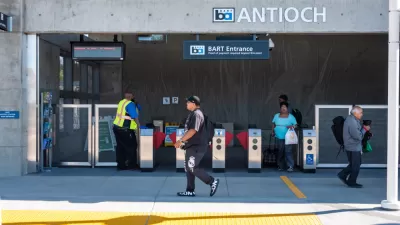In the Bay Area, where transit and cycling are encouraged and on the rise, cyclists are increasingly turning towards folding bikes to enjoy unrestricted access to the two major rail systems, BART and Caltrain, due to conventional bike limitations.
"Folding bikes are not the most chic thing. They are more practical," said BART spokesman Linton Johnson. "We are seeing a lot more people turning to bikes to save on a gallon of gas, and folding bikes are the way to go."
"[F]olding bikes can be taken on any BART train at any time, which is not the case with regular bikes, which are subject to restrictions at certain stations during commute hours.
Although folding bikes have been growing in popularity, they still account for only a very small segment of bike sales in the United States. Of the estimated 18 million new bikes sold in 2007, only about 100,000 were folding bikes, according to Jay Townley of Gluskin Townley Group, a bicycle marketing and research firm.
"The folding bike business is growing. We are looking at a major uptick this year," he said.
Townley said part of the increase is linked to rising gas prices - but another factor is the impact of the "new urbanism," which has led to more people choosing to live in denser urban areas that have transit-oriented developments and housing."
From SF Chronicle:
The Bay Area's other commuter rail system, Caltrain, while not have restrictions on bike access like BART, has its own problem of ‘bumping' which occurs when demand exceeds capacity. They have developed a new plan which includes "recommendations to set up a subsidy program to help people buy folding bikes that can be stowed under the seats " as well as other measures to accommodate cyclists. [See related links.]
Thanks to MTC-ABAG Library
FULL STORY: Folding bikes: a transit alternative

Manufactured Crisis: Losing the Nation’s Largest Source of Unsubsidized Affordable Housing
Manufactured housing communities have long been an affordable housing option for millions of people living in the U.S., but that affordability is disappearing rapidly. How did we get here?

Americans May Be Stuck — But Why?
Americans are moving a lot less than they once did, and that is a problem. While Yoni Applebaum, in his highly-publicized article Stuck, gets the reasons badly wrong, it's still important to ask: why are we moving so much less than before?

Research Shows More Roads = More Driving
A national study shows, once again, that increasing road supply induces additional vehicle travel, particularly over the long run.

Judge Halts Enforcement of Anti-Homeless Laws in Grants Pass
The Oregon city will be barred from enforcing two ordinances that prosecute unhoused residents until it increases capacity and accessibility at designated camping sites.

Advancing Sustainability in Los Angeles County Schools
The Los Angeles County Office of Education’s Green Schools Symposium brings together educators, students, and experts to advance sustainability in schools through innovative design, climate resilience strategies, and collaborative learning.

Using Old Oil and Gas Wells for Green Energy Storage
Penn State researchers have found that repurposing abandoned oil and gas wells for geothermal-assisted compressed-air energy storage can boost efficiency, reduce environmental risks, and support clean energy and job transitions.
Urban Design for Planners 1: Software Tools
This six-course series explores essential urban design concepts using open source software and equips planners with the tools they need to participate fully in the urban design process.
Planning for Universal Design
Learn the tools for implementing Universal Design in planning regulations.
City of Moreno Valley
Institute for Housing and Urban Development Studies (IHS)
City of Grandview
Harvard GSD Executive Education
NYU Wagner Graduate School of Public Service
City of Cambridge, Maryland
Newport County Development Council: Connect Greater Newport




























